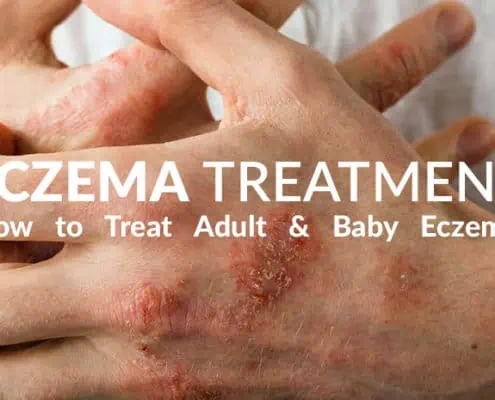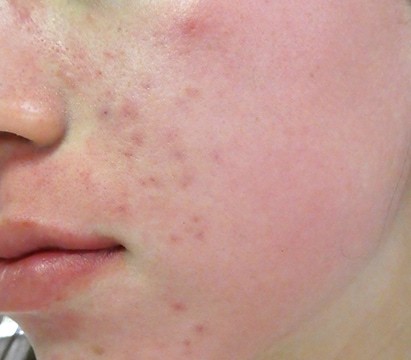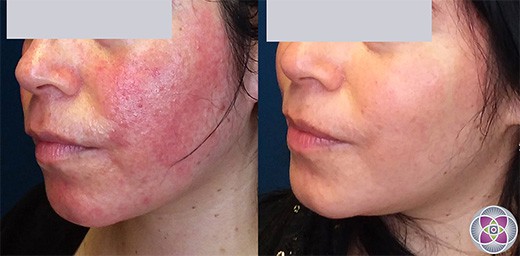
OC 949-428-4500
LA 310-460-2444

Rosacea (ro-zay-sha) as its name implies – sounds like “rose” – is simply redness in the skin of a person’s face. It is quite common, affecting over 10 million people in the United States and approximately 45 million worldwide.
Rosacea affects mainly people with pale skin, primarily Caucasians from Irish, Scottish or English descent, though it is not unusual among other white Europeans and a smaller percentage of Asians. Though the disorder is more frequently found in women, the condition tends to be more severe in men.
Unfortunately, as the condition becomes more severe, 90% of patients report that rosacea has lowered their self-confidence and self-esteem, and over 40% percent report that the symptoms have harmed their social life, causing them to avoid public contact and even take sick leave from work.
Rosacea presents itself as a wide spectrum of symptoms from simple “rosy cheeks”, wherein the skin of the face may “blush” red or pink, to progressively more serious symptoms, such as dilated blood vessels, to spider veins (called telangiectasias), to small red bumps (papules) that may be filled with pus that can also ooze causing the skin to be swollen, shiny and wet. In severe cases with oozing pustules it is often called “Acne Rosacea”. Fortunately, rosacea is not contagious or infectious.
There are 4 different subtypes of rosacea.
This subtype is known as Erythematotelangiectatic rosacea (ETR). It presents itself on the central face as flushing, persistent redness and visible blood vessels. It often occurs prior to, or along with, the pimples and bumps of subtype 2 rosacea.
This subtype is also known as Papulopustular, or acne rosacea. It presents itself with redness and acne-like breakouts. Middle aged women are most likely to be affected by this subtype.
This subtype is known as Phymatous rosacea or rhinophyma. It most commonly affects men and presents itself as a thickening of the skin and enlargement of the nose.
This subtype is known as Ocular rosacea. It presents itself around the eye area as excessive eye irritation and swollen eyelids. Other symptoms include excessive tearing, dry or burning eyes and lost vision.
The symptoms of rosacea are numerous and can vary from person to person. It is essentially a spectrum of facial redness, that can span from simple “rosy checks”, to a serious pathology of the skin that is disruptive to lives of those who suffer from it.
What is important to understand is that it is not just about redness in the surface layers of the skin, because underneath the redness there is an underlying weakness of the collagen matrix of the dermis that must be addressed in order for the cause of the rosacea to be healed.
The following are the most common symptoms of rosacea that people experience as well as what causes them.
Episodes of blushing can last for several minutes and can be accompanied by the skin feeling excessively hot. This blushing can begin on the face and spread to other areas such as the neck and chest.
The cause of these symptoms can be a function of even the simplest of things, such as emotional situations like being embarrassed, or as a result of food sensitivity such as red wine, spices or MSG, and of course, it can be the result of exercise or simply being hot.
Bottom line, for some, the dilation of the blood vessels in the skin of their face that turns their skin red can happen very easily, as a result of all sorts of daily innocuous provocations that would not even be noticed by most other people.
Simply touching your face can cause the dilation of sensitive blood vessels and make the symptoms appear worse. Physical stimuli such as sunlight can also cause this dilation.
Often mistaken as sensitive skin, it is actually caused by sensitive blood vessels.
Also known as inflammatory rosacea, or “gin blossom”, these small bumps usually appear on the nose and cheek area and are often confused with acne.
In the case of rosacea, the skin is truly inflamed, is typically sensitive to the touch, and might even be oozing an oily liquid fluid that makes it shiny and bright.
Also known as vascular rosacea, these spider veins on the nose and cheeks become more visible as they swell causing the skin to become blotchy. They often resemble a spider web, hence their name, and are usually a sign that the rosacea is progressing and getting worse.
A rare condition that causes the nose to become enlarged and bulbous due an overgrowth of collagen and sebaceous glands.
Males are more likely to develop this condition than females. It is often associated with men who consume a lot of alcohol, and as mentioned previously, alcohol consumption does cause the dilation of blood vessels in the skin. However, this condition can occur in people who do not drink alcohol at all.
Causes burning, itching and redness of the eyes. The inside of the eyelid may appear scaly and become inflamed. The outside of the eyelid may become red and swollen.
Symptoms can also include sensitivity to light, tearing, and in rare cases, blurred vision.
A buildup of fluids and proteins in the facial tissue caused by leaking blood vessels. This fluid usually collects above the nasolabial folds creating the appearance of “baggy” cheeks.
Exactly what causes rosacea is not known, though we do know that it is an inflammatory process that involves the dilation and inflammation of the blood vessels in the skin of the face.
Conventional wisdom indicates that it has a genetic component that is then aggravated by environmental conditions such as excessive sun exposure, environmental toxins, skin mites called demodicosis (Demodex folliculorum) that infest hair follicles, and of course reaction to certain medications. Other elements that are known to cause or trigger the symptoms are alcohol consumption, exercise, smoking, spicy food, and emotional upsets.
From a scientific point of view, rosacea remains largely an enigma. While we know what it is, we simply do not know what causes it.
Not surprisingly, we also do not know why various treatments work, or don’t work. Even more confusing is the fact that some treatments that work on a specific case or cause will not work on others.
Furthermore, just like the many treatments that sometimes work and sometimes don’t, many different factors seem, in some cases, to “trigger” the rosacea, while in other cases not at all. Some of the different factors that can “trigger” or cause it include…
So far no one has been able to establish a direct causal relationship between any of these “triggers” that consistently cause rosacea. The underlying cause or causes are simply a mystery.
Though the intensity of rosacea in the typical patient may vary from day to day, overall, it gets worse the longer a person has the condition. Bottom line, time is not on your side, and the longer you wait the worse it will typically become. Therefore, the sooner you treat the rosacea the easier and more effective the treatments will be.
Though many Dermatology medical books indicate that it is an incurable auto-inflammatory illness, we have developed advanced protocols using medical grade lasers that are very effective in treating even the most dramatic cases.
In the final analysis, from the perspective of a patient, we are left with unhappy skin that is suffering from a combination of symptoms whose cause or causes we cannot identify.

Consequently, the physician’s job is now simplified. Set aside all the scientific theories and focus on developing treatments that alleviate the symptoms and that make the skin happy. As in all therapies, we want to utilize the most natural methods possible that don’t expose you to detrimental “side effects” that disrupt other aspects of your physiology. And of course, we want rosacea treatments that produce long lasting results and go directly after the cause of the redness.
For practitioners of “evidence based medicine”, even when the causes are unknown, our primary focus remains identifying “what actually works” in treating your rosacea. Armed with that knowledge we can then customize a combination protocol from “all the things that work” in order to maximize your individual results from the treatment.
There is a path that is right for you to successfully treat and heal your skin!
When asking your doctor about your rosacea you must remember that your doctor only sees your symptoms framed within a “snap shot” in time when you happen to be in his/her office, and therefore he/she has no idea how your skin responds to various inputs and treatments on a continuous basis.
You are the one who has to take notice of what and how your skin responds to everything that might be affecting its condition. Then, as the pieces of the puzzle take shape, with your doctor’s help, you might be able to arrange the data in such a way so that a clear picture of what makes your skin happy can emerge.
The bottom line: notice everything and take notes. What things upset your skin and trigger the redness, and what things make your skin happy and reduce the redness.
Doctors Alice Pien, MD and Asher Milgrom, Phd are established pioneers in the fields of Regenerative Medicine and Skincare. Their expertise ranges from advanced laser systems to HCT/P – Stem Cell medicine. Their medical education and advanced certifications span from medical schools of NY State University, the University of Chicago, to Johns Hopkins, Harvard and UCLA. They approach medicine with the clinical expertise of over 85,000 successful treatments over the past 20 years and significant scientific research resulting in proprietary protocols that they customize for each individual patient.
AMA Regenerative Medicine & Skincare | 1570 Brookhollow Dr., Santa Ana, CA 92705 | 6310 San Vicente Blvd STE 285, Los Angeles, CA, 90048 | Privacy Policy